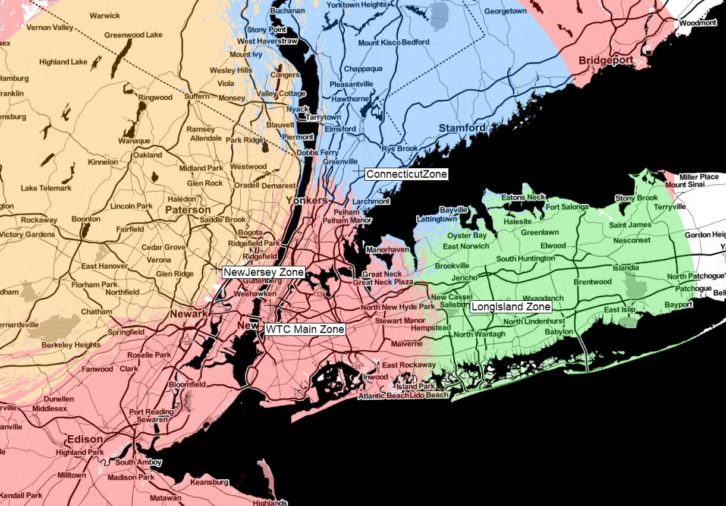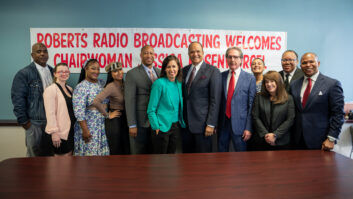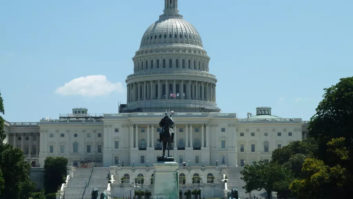
If the Federal Communications Commission decides to allow FM boosters to originate programming anytime soon, it will do so against the wishes of some of the largest U.S. radio groups.
The company pushing the change says its technology would allow broadcasters to use boosters to “geo-target” parts of their signal areas with hyper-localized content.
But the National Association of Broadcasters in February came out strongly against the idea in comments to the FCC.
Cumulus, Entercom, Beasley and iHeartMedia also questioned the technical soundness of geo-targeting; they urge further field testing to answer questions about possible interference.
Even some supporters of the idea now are using more cautious language and urging further testing.
No doubt aware of these critical reactions, GeoBroadcast Solutions issued a statement saying that it views the current phase of FCC vetting as “the beginning of an active debate on innovation in the radio industry.”
Willing ears
FM broadcasters use on-frequency boosters to help fill gaps in coverage often caused by terrain shielding. Current rules require a booster simply to retransmit the signal of the originating station.
GBS wants to give FM stations the ability to air very localized ads, news and other content for a few minutes per hour using synchronized boosters. GBS and other proponents say such geo-targeting would bring numerous benefits to stations and advertisers.
GBS has lobbied the FCC for approval; and its proprietary system, trademarked as ZoneCasting, has been tested in Milwaukee, Wis., on WIIL(FM) under experimental operation. The FCC recently approved a field test at KSJO(FM) in San Jose, Calif.
The idea has found some willing ears at the commission, with Commissioners Brendan Carr and Geoffrey Starks voicing support for the idea. The commission has an open Notice of Proposed Rulemaking; the comments quoted in this story were filed in that NPRM.
That comment period drew support from smaller stations, many of which filed nearly identical comments, vs. the more cautionary tone of some large groups who worry the proposal offers no great benefit and could become a detriment.
At the first filing deadline, GeoBroadcast Solutions said in a statement: “Some parties oppose new technologies and innovation, and that is a familiar story for those who have watched broadcast media evolve over the decades. However, a broad range of large and small stations and broadcast groups, the advertising community and minority coalitions, have indicated their desire to embrace innovation and the future by using broadcast airwaves for a more personal and localized experience.”
Emergency benefits
Dockins Broadcast Group, which operates FM stations in several small markets in Florida and Missouri, told the FCC the ability to geo-target weather warnings and road closures would be invaluable.
“Emergency alerts would be more impactful. Zoned coverage would make radio much more attractive to small businesses, who would be able to reach targeted audiences more effectively and efficiently,” Dockins wrote.
Keyhole Broadcasting, licensee of three FM stations in Wyoming, commented: “Keyhole would be able to utilize zoned broadcast coverage to provide targeted emergency alerts, local news and public interest programming and live local events of interest to small portions of the main service area.”
Some believe geo-targeting would benefit underserved populations, according to Emmis Communications.
“We agree with the MMTC [Multicultural Media, Telecom and Internet Council] that by creating the availability to geo-target content, the proposed rule could increase the amount of content targeting minority communities, such as second-language programming,” Emmis wrote.
Opponents have focused on potential interference to the primary and adjacent stations, but they voice economic concerns, too.
The NAB’s opposition is likely to be influential, given that potential benefits to broadcasters are among the selling points of the concept.
The association says it “strongly opposes” revising the rules. It says geo-targeting via boosters pose potentially seismic risks to the FM band: “A close review of the notice suggests that rather than bolster the industry’s economic outlook, GBS’s proposal would instead undermine the industry’s fundamental business model.”
The association believes program origination on boosters “will almost certainly drive both advertising rates and revenues down as advertisers push to purchase geo-targeted ads.”
And it said potential interference remains a concern for its members.
“Broadcasters are extremely concerned that the interference caused by geo-targeting where the boundary of a primary station meets a booster airing different programming will spur listeners to change to an alternative platform and reflect poorly on the reputation of FM radio service,” NAB asserted.
“The record lacks any real-world testing of GBS’s system under certain critical circumstances sufficient to allow stakeholders to reasonably assess the technical impact of GBS’s proposal.”
“Transition areas”
The joint filing by Cumulus, Entercom, Beasley and iHeartMedia went into more detail: “While ZoneCasting is being promoted as causing merely ‘manageable’ co-channel interference (or self-interference), the test results and study placed in the record by GBS fail to substantiate that claim.”
The group continues expounded on GeoBroadcast’s WIIL(FM) test report: “Delving into the fine print of the WIIL/Milwaukee Report, GBS identifies ‘Transition Areas’ — clearly a euphemism for ‘Interference Areas’ — along three parallel drive routes (of unspecified vehicle speed) ranging from 12 to 23 seconds, 22 to 24 seconds, and 23 to 30 seconds. This significant degree of conceded interference is hardly the ‘negligible amount’ of interference promoted by GBS.”
In addition, experimental testing of Zonecasting, they said, has ignored the impact of booster origination on HD Radio and the Emergency Alert System.
Moreover, the four groups raised the possibility of ZoneCasting creating the risk of advertisers flocking to “population clusters deemed more valuable” or “Gold Coast neighborhoods” at a slight increase in dollars per capita but leaving areas seen as less desirable unsold.
“Not only would this cherry-picking undermine GBS’s promise of higher premiums from ZoneCasting, it would further broaden the fragmentation already seen with advertisers buying a few top radio stations, while completely ignoring other stations, including those owned by minority, woman and small-business broadcasters,” the broadcasters wrote.
NAB and others also expressed concern about possible degradation in the public’s perception of FM quality.
Cromwell Group, which owns stations in medium and small markets, said interference between primary stations and FM boosters is already common.
“If geo-targeting grows, radio listeners may begin to perceive radio as a service that is garbled and unreliable. That perception is unlikely to be limited to only the stations that are using GBS technology and could affect audience perception of radio generally, negatively impacting the entire industry.” Cromwell supports further testing instead.
“Growing concerns”
Support from minority interest groups has been an important part of this story recently.
But Urban One, which initially backed the idea because of its potential to increase business and ownership opportunities for minorities and women, expressed “growing concerns that the proposal might have significant unintended negative consequences to our diversity initiatives.”
In particular, it said, “we fear the adoption of geo-targeted technology within the radio industry operation will only result to drive down advertising revenues necessary for stations to thrive and continue to serve their communities.”
Urban One continued: “This comes precisely at a time when the radio industry is already under significant pressure from new advertising competitors and the ongoing stresses of the novel coronavirus pandemic.” It asked the FCC not to adopt the proposed changes.
The former director of the Federal Emergency Management Agency, Craig Fugate, had been vocal about the value of geo-targeting via radio in times of emergencies. But now Fugate urges a more patient approach.
“I respectfully urge that changes to the FCC’s FM booster rules not be adopted before the proposed system is tested and shown to work reliably with the EAS system,” he commented.
FEMA itself contributed thoughts on the proposal and its possible impact on the Emergency Alert System: “FEMA finds that there is little assurance in the record that EAS performance in and around such booster zones will not be negatively affected. FEMA’s concerns are in two distinct transitional areas — geographic and temporal — along with an EAS operational concern.”
FEMA is operator of the national-level EAS system and is directed to ensure the president has the ability to alert and warn the civilian population in times of emergency.
Writing in favor of the proposal, manufacturer GatesAir noted that it worked with GeoBroadcast solutions to introduce the MaxxCasting system that forms the basis for ZoneCasting. The latter uses the Synchrocast feature of GatesAir Intraplex codecs.
GatesAir said that interference concerns behind the longstanding restriction on booster origination are no longer present.
“(MaxxCasting) uses a network topology and GatesAir’s Flexiva transmitters and Intraplex SynchroCast systems to provide targeted, over-the-air radio broadcasting that expands market coverage in a more effective manner than traditional signal booster technologies. MaxxCasting minimizes or eliminates interference with both a station’s primary, co-channel, signal and with the signals of boosters associated with other stations operating near the FM booster station.”
It continued: “The MaxxCasting system has a proven track record of allowing radio stations to expand their signals without causing interference previously associated with FM boosters, and thereby solving the technical concerns underlying the prohibition on independent programming.”
BIA Advisory Services said its own research on the radio industry concluded that geo-targeted ads can increase radio’s revenue. The research company also cited data from Edison Research showing consumers prefer listening to more localized content, including localized commercials.
When this article was written, GBS declined further comment ahead of an FCC reply deadline. You can read our coverage of the company’s subsequent reply comments here. Also subsequently, two major minority advocacy groups called for an industry pilot program in light of the opposition comments.
You can see all the publicly filed comments on this issue at www.fcc.gov/ecfs/. Type “20-401” in the “Specify Proceeding” field.










